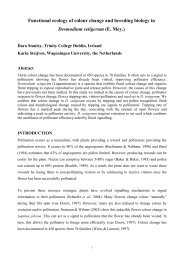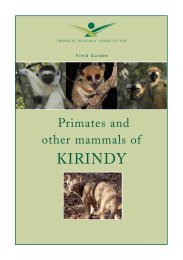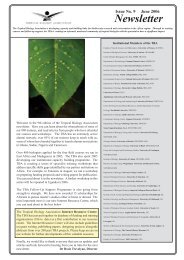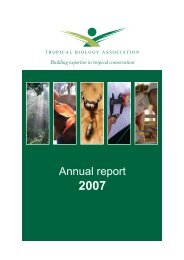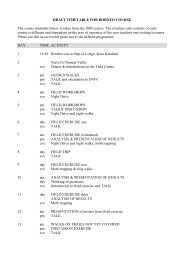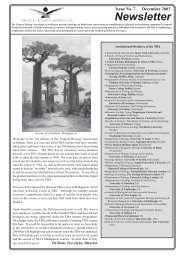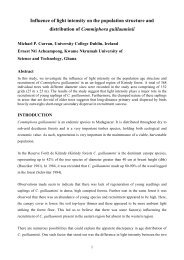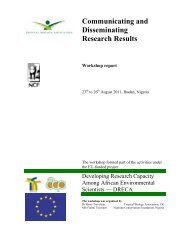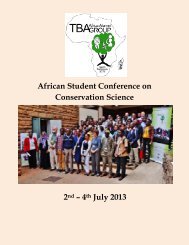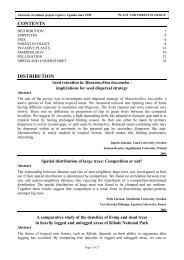Download TAAG Book of Abstracts - Tropical Biology Association
Download TAAG Book of Abstracts - Tropical Biology Association
Download TAAG Book of Abstracts - Tropical Biology Association
You also want an ePaper? Increase the reach of your titles
YUMPU automatically turns print PDFs into web optimized ePapers that Google loves.
Altitudinal Distribution <strong>of</strong> Amphibians and Prevalence<br />
<strong>of</strong> Chytrid Fungus Batrachochytrium dendrobatidis in<br />
Bwindi Impenetrable National Park, Uganda<br />
Sekisambu Robert S.<br />
Makerere University Department <strong>of</strong> Enviornmental<br />
Sciences, Uganda<br />
Email for correspondence: rsekisambu@gmail.com<br />
Abstract<br />
Amphibians are vulnerable taxa yet poorly known<br />
particularly in the Albertine Rift where many rare and<br />
endemic species occur. I report on the diversity and<br />
altitudinal distribution <strong>of</strong> amphibians in Bwindi<br />
Impenetrable National Park and the incidence <strong>of</strong> Chytrid<br />
fungus (Batrachochytrium dendrobatidis) –the causative<br />
agent <strong>of</strong> Chytridiomycosis disease associated with a<br />
global decline in amphibian populations and rapid<br />
species extinctions. I adopted the time constrained<br />
Visual Encounter Survey (VES) to sample 45 sites in 9<br />
major sectors <strong>of</strong> Bwindi (1190m -2607m) for 41 field<br />
days (68.5 hours) between December 2010 and<br />
September 2011. A total <strong>of</strong> 1,309 frogs were<br />
encountered representing 36 amphibian species, two<br />
(Ptychadenaanchietae and Leptopeliscalcaratus) <strong>of</strong><br />
which were new records for Uganda. Although the<br />
highest number <strong>of</strong> species (25) were encountered at<br />
mid altitude (1600m-2000m), there was a monotonic<br />
linear decline in the number <strong>of</strong> species encountered per<br />
hour with increase in altitude. The number <strong>of</strong> individuals<br />
<strong>of</strong> a dominant species Leptopeliskivuensis increased with<br />
increase in altitude. Out <strong>of</strong> the 197 frogs sampled, 37<br />
frogs (18.8%) tested positive for Chytrid fungus<br />
(Batrachochytrim dendrobatidis) and prevalence<br />
increased with increase in altitude (R 2 =0.243); these<br />
represent 10 out <strong>of</strong> the 30 species sampled. A rare<br />
species Leptopelischristyi had the highest prevalence<br />
(100%) <strong>of</strong> all sampled species. I recommend use <strong>of</strong> this<br />
baseline data for long term monitoring <strong>of</strong> amphibian<br />
diversity much needed in studying altitudinal shifts in<br />
species distribution and localized declines in amphibian<br />
encounter rates linked to global warming and<br />
ecosystem changes in protected areas.<br />
Keywords: Fungus, altitude, frogs, Albertine Rift<br />
Impacts <strong>of</strong> Domestic Energy Consumption on<br />
Biodiversity Loss: Assessment <strong>of</strong> Charcoal as<br />
Household Energy in Benue State, Nigeria<br />
1,2 *Babalola, Folaranmi D. and 3 Opii, Egbe E.<br />
1 Centre for Environmental Economics and Policy in<br />
Africa, University <strong>of</strong> Pretoria, South Africa<br />
2 Department <strong>of</strong> Forest Resources Management,<br />
University <strong>of</strong> Ilorin, Nigeria<br />
3 Akperan Orshi College <strong>of</strong> Agriculture, Yandev, Benue<br />
State, Nigeria<br />
*Email for correspondence: folababs2000@yahoo.com<br />
ABSTRACT<br />
Charcoal has been an important domestic cooking<br />
energy for many years and has wide market acceptance<br />
in developing countries. It has also been discovered that<br />
production <strong>of</strong> charcoal contributes to forest degradation<br />
as well as destruction <strong>of</strong> vast area <strong>of</strong> tropical forest. It is<br />
assumed that increase in the consumption <strong>of</strong> charcoal at<br />
household level will definitely lead to demand for more<br />
charcoal and ultimately increase in the production <strong>of</strong><br />
charcoal to meet the demand; this translates loss <strong>of</strong><br />
more tree diversities as a result <strong>of</strong> tree felling for<br />
charcoal production. This study was therefore<br />
conducted to assess the socio-economic factors<br />
influencing consumption <strong>of</strong> charcoal by household in<br />
Benue State, Nigeria. Benue State is located in the<br />
middle belt <strong>of</strong> Nigeria with high level <strong>of</strong> charcoal<br />
production and usage at the household level. Structured<br />
questionnaire was administered to selected households<br />
within the State. It was discovered that the use <strong>of</strong><br />
charcoal is on the increase with about 76.7% <strong>of</strong> the<br />
sampled households use charcoal as cooking fuel almost<br />
every day <strong>of</strong> the week. The most competitive alternative<br />
cooking fuels to charcoal used by the sampled<br />
household were kerosene and firewood. Affordability as<br />
a result <strong>of</strong> cheaper cost (62.8%) and consistent<br />
availability constituted the main reasons for using<br />
charcoal when compared with other domestic energy<br />
sources. Total stoppage to production and usage <strong>of</strong><br />
charcoal at household level in the short run is not<br />
feasible. Therefore, sustainable production <strong>of</strong> charcoal<br />
through plantation establishment to meet timber<br />
demand and efficient use <strong>of</strong> the charcoal at household<br />
through introduction <strong>of</strong> efficient cook stove are<br />
recommended to reduce impacts on the remaining<br />
natural forests in the study area.<br />
Keywords: Charcoal, Domestic energy, Cooking fuel,<br />
Preference, Socio-economic factors<br />
<strong>TAAG</strong> First African Student’s Conference, Nairobi. 2-4 July, 2013 25




